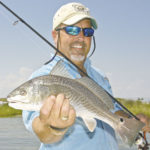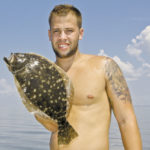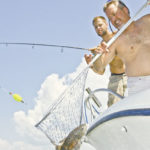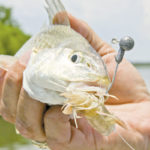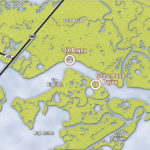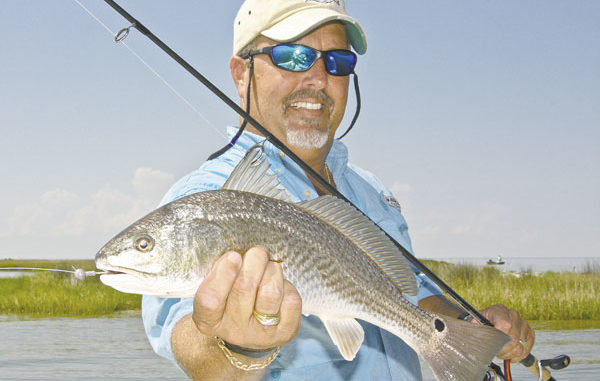
Angler targets bull croakers in summer, fall
Scott Castaing has a sense of where he’s come from. That’s one of the reasons his favorite kind of fishing is for croakers big enough to fillet.
“Back to basics…” he told me as we idled away from his dock in Rigolets Estates on the north shore of Lake Pontchartrain. “Everybody nowadays wants the mule trout or the bull red. I like to do that, but I also like to keep it simple. Nothing’s more simple than fishing a piece of shrimp on the bottom for bull croaker.”
Little did he know at the time, but the “back-to-basics” trip that Castaing, his son Shane and I were embarking on would be anything but back to basics.
Oh, there was a lot of what Castaing called “beer fishing,” throwing a shrimp under a cork and just letting it sit, but there was also a wild goose chase, a seminar in how to operate a business with a smart phone and a gumbo box.
“I couldn’t sleep at all last night,” Castaing said as we idled up toward Alligator Point on the western side of Lake Borgne. “I was so excited to be able to get up early to go fishing rather than go to work that I felt like a kid on Christmas Eve.”
Castaing took me fishing to catch bull croaker, but he knew that we were about a month or two early for the best croaker bite. That’s why he made the decision to run to Alligator Point first to try our luck with the redfish.
A neighbor of his had been limiting out on Alligator Point a few days leading up to this trip, and he wanted to get the monkey off his back and put some sure things in the boat so we wouldn’t go home empty-handed.
We had a baitwell full of live shrimp that Shane Castaing had picked up for us down at Rigolets Marina earlier that morning. Now three of those shrimp were hanging beneath popping corks near a couple patches of shell along the bank. That’s when Scott Casting’s smart phone began to ring, and ring, and ring, and ring.
Castaing owns and operates CASS Marine Group, and apparently he failed to send out the memo that he would be doing a little different kind of work on the water this day. He expertly maneuvered tugboats and handled financial issues all from his smart phone while he waited for his cork to go under.
Unfortunately, his smart phone business meetings were never interrupted by even the slightest nibble.
“Let’s pick up and move around the point and try another spot,” he said. “My neighbor didn’t really catch them until later in the morning, maybe 10 o’clock.
“We’ll poke around for a little while and come back here later to see if they’ve turned …”
“Don’t think so,” I grunted as my rod bowed deeply against the weight of a fish that obviously had some shoulders on it. “We’re not going to have to wait ’til 10 today. Looks like the redfish are just a little bit early.”
The bite didn’t last long, though. In fact, it lasted for only one fish. So we eventually pulled in the anchor and idled around the point only to find a high-school friend of mine anchored up in his new boat. They had only caught two redfish and two flounder, so we made the decision to fish the little satellite rig beside the larger Alligator Point rig.
We didn’t have very high hopes because the water looked muddy and fresh because of the Mississippi River water that was still hugging the western side of Lake Borgne. We fished the shell bottom at the base of the little structure, and there were plenty of tiny croaker tugging on our shrimp, but no trout were around.
Our plan A was to fish Castaing’s croaker holes, and our plan B was to fish the redfish around Alligator Point. We were going to start with plan B and hit plan A on our way back into Rigolets Estates. We were already drifting away from plan B by trying the trout, so we decided that part of getting back to basics sometimes meant looking for new places to fish.
We had heard that Half Moon Island north of the Biloxi Marsh had some pretty water with schools of baitfish sandwiched between birds above and trout below, so Castaing, who had never fished Half Moon Island before, decided that it would be worth the wild goose chase to go get in on some of that action.
Birds were diving and shrimp were jumping as we approached the western side of Half Moon, and we could see scattered signs of trout slashing into the shrimp. Castaing idled his boat into the middle of a lively looking pocket, and dropped anchor.
Over the course of the next hour or two, we landed redfish, speckled trout and flounder. We never could get the trout to bite under the birds because the action was so spread out, so we focused on points that had slight tidal movement around them.
The points that had baitfish movement around them were most productive, and it was a great way to fish considering we were on anchor the whole time. Each point gave up four or five fish, so we just jumped points until Castaing thought it was time to go try his croaker holes.
On the way back toward the Rigolets, Castaing explained why he goes after bull croaker.
“Mostly croaker are easy to catch, and they’re a blast to catch,” he started. “It’s what Dad took us out fishing for when we were kids.
“We had a camp on Lake Catherine, and we croaker fished there and I grew up in Gentilly on the Lakefront. There were a ton of croaker along the seawall.”
Castaing says croaker fishing has been really good in Lake Pontchartrain since Hurricane Katrina, and he’s looking for it to be even better this September, October and November because of the shrimping basically being shut down last year due to the oil spill.
“Those are the three best months, so we’re a little early,” he continued. “They’re still there, but they just seem like they’re more ganged up in the croakers holes those three months.
“The biggest croaker I’ve caught out here was 16 inches … maybe 1 1/2 or 2 pounds.”
We made our way into Goose Pond Bayou, where Castaing dropped anchor in one of the sharp, outside bends so he could cast back toward the inside point. Croaker are found on the bottom, so he had rigged up a Carolina rig heavy enough to keep his shrimp down where the croaker live.
“Croaker holes are deeper than the surrounding area,” Castaing said. “You can go out by the Twin Spans. That’s really one of my favorite places to go because croaker get all over those pilings. When you get in a good bull croaker hole, you can easily catch 50, and you don’t have to have live bait. Market bait works, and that’s the beauty of it.”
The hole in Goose Pond Bayou wasn’t full of fish, but it did give up a few fillet-sized croakers. It wasn’t a fast enough bite for Castaing, though, so we pulled up and headed toward 4X Bayou on the north shore of the Rigolets. That’s where the allure of croaker fishing was made known to me.
I started getting bit about 15 yards off the bank on just about every cast. And the croaker were so big, I would have sworn that they were small redfish had they gotten off.
“When Shane was little, we would sit at a spot like this all day long and let him catch croaker after croaker,” Casting recalled. “We’ve got pictures of him holding up little croakers and big croakers just like they were giant trophies.
“Just like here, we could sit here until the evening hours, and it would get better when the tide started moving. When you get one, you’re going to get more. You’re not going to catch one and that be a wrap.”
By the time an ominous thunderstorm over Slidell forced us to call it a day, Casting, his son Shane and I had put together a gumbo box of redfish, speckled trout, flounder and bull croaker. And there was no doubt which ones Casting’s family was going to eat first.
“That’s my wife’s favorite fish,” Castaing said. “You can grill them on the half shell because they have the same skin texture as a redfish. But you can also pan fry the fillets, or you can just gut them, skin them and fry them whole.
This entire fishing trip wound up being somewhat of an allegory representative of Castaing’s back-to-basics fishing philosophy. The siren songs of the redfish, trout and flounder at Alligator Point and Half Moon were too tempting to pass up, but we eventually wound up right where he wanted to be — in his croaker holes.
I don’t recall his phone ringing while we were on his croaker holes, but I’m sure if it did, it went unanswered. Scott Castaing was back where he belonged. In his mind, in his boat, in his box, he was home.
